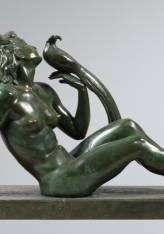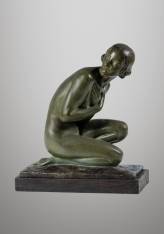ALLIOT Lucien
ALLIOT Lucien
Lucien Charles Édouard Alliot was born in Paris on November 16, 1877, into a family deeply rooted in the sculptural arts. His father, Napoléon Alliot, a renowned sculptor, instilled in him from a young age the passion and craftsmanship of this art. Following in his father's footsteps, Lucien became a distinguished sculptor.
As a promising student of two great sculptor masters of his time, Louis-Ernest Barrias and Coutan, Lucien Alliot received a solid education at the École des Beaux-Arts in Paris. Early on, his talent became apparent, and he exhibited his first works at the Salon de la Société des Artistes Français as early as 1905.
In line with the Art Nouveau movement, Alliot distinguished himself with graceful and elegant sculptures, featuring allegories and dancing female figures. However, his work evolved over time, gradually shifting towards more religious compositions, marked by profound spirituality. This transition led him to collaborate with Maison Raffl, notably for the creation of religious sculptures distributed in the shops of Rue Saint-Sulpice.
One of his most famous works remains the first statue of Sister Thérèse, created in 1909. Under the watchful eye of the Carmelite sisters and Mgr de Teil, Alliot undertook the creation of several other representations of Thérèse, closely collaborating with the Carmel to capture the essence of the saint. Among his most notable achievements are the group depicting Mr. Martin and Thérèse in the garden of Les Buissonnets, as well as the statue of Thérèse in prayer, now exhibited in the chapel courtyard.
Alliot's renown extended far beyond French borders, with his works present in numerous museum collections worldwide. His dedication to his art and sculptural legacy persisted until his death on March 9, 1967, leaving behind an indelible artistic legacy and a significant contribution to the history of French sculpture.


